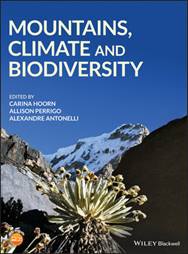
Mountains and volcanoes have long received attention from geoscientists, being such impressive geological features. Alexander von Humboldt (1769-1859), following travels in Latin America, noted that there is a global relationship between biota and elevation in addition to that between biota and latitude. Even so, the climatic effects of orogenisis, and how mountains and (palaeo)climates together influence extinction, speciation (the evolutionary origin of species) and species’ migrations, remain topics of debate. Prior to this publication, no single volume had addressed the complexities of these interactions. The 31 chapters presented here address our current knowledge of these topics more or less comprehensively.
Mountains are landforms that rise prominently above their surroundings, have relatively confined summit areas (sometimes forming biotically isolated “sky islands”) and considerable relief (ruggedness). Early chapters review our knowledge of mountain formation through tectonic plate collisions and dynamic topography (uplift by mantle convection). Means of measuring palaeotopography are outlined, such as exploiting altitudinal changes in oxygen and hydrogen/deuterium isotopic ratios of rainfall and deposits. Also described is the field of phytopalaeoaltimetry—using plant fossils and leaf shapes (the Climate Leaf Analysis Multivariate Programme—CLAMP) as proxies for altitude. A regrettably brief chapter discusses measuring biodiversity, but most chapters present primarily species richness as a measure.
How can there be a relationship between dynamics and species richness, given that mountain building and evolution are processes acting at markedly different rates? We are informed that stable mountain areas (e.g., in Australia) host diverse, mature radiations, while rapid radiations are occurring in tectonically active areas (e.g., New Zealand). Mountains with much ruggedness have greater richness than do those with little topographic complexity, especially in the tropics. Meanwhile, continuous mountain chains act as corridors for migration for high-altitude species, while also being barriers for low-altitude ones. A trio of maps contrast present-day ruggedness, vascular plant species per 10,000 km2, and terrestrial mammals, and make the links visually clear. Five major global centres for vascular plant diversity are identified, all in or adjacent to mountainous regions (Andes, Rockies, East African Rift System, the European Alps and Yunnan, SW China).
Ten chapters provide case studies worldwide. Each makes interesting reading. I was particularly intrigued to read, for example, that the isolated ice-free coastal areas and nunataks (ice bound “mountain islands”) in Antarctica have rich, geologically ancient moss and lichen communities occupied by tardigrades and mites nowadays able to withstand prolonged desiccation and freezing. This welcome volume deserves to be widely read.
Reviewed by Brent Wilson
MOUNTAINS, CLIMATE AND BIODIVERSITY, by Carina Hoorn, Allison Perrigo, Alexandre Antonelli (eds), 2018. Published by: Wiley-Blackwell, 544 p. hbk. ISBN: 978-1-119-15987-2. List Price: £70.00. W:
www.wiley.com